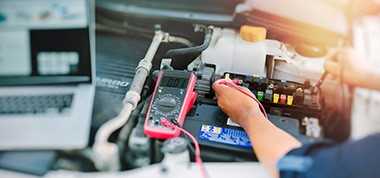|
|
Introduction and selection criteria of high-power DC regulated power supplyIssuing time:2024-02-27 18:14 There are two main types of high-power DC regulated power supply, one is linear DC regulated power supply, and the other is high-frequency switching DC regulated power supply (Xingzhongke mainly produces this switching DC regulated power supply). Linear DC regulated power supply The working process of the main circuit of the linear DC regulated power supply is that the input power supply is first converted into a DC power supply by the pre-regulated circuit after the initial AC voltage regulation, and then the linear adjustment element is finely adjusted under the intelligent control of the control circuit and the monolithic microprocessor controller, so that it can output a high-precision DC voltage source. 1. Power transformer and rectifier: convert the 220V or 380V alternating current of the mains power into the required direct current. 2. Pre-voltage regulation circuit: relay components or thyristor components are used to pre-adjust and pre-stabilize the input AC or DC voltage, so as to reduce the power consumption of linear adjustment components and improve work efficiency. And ensure that the output voltage source is high precision and high stability. 3. Linear adjustment element: fine adjust the filtered DC voltage to make the input voltage meet the required value and accuracy requirements. 4. Filter circuit: to prevent and absorb the pulsating wave, interference and noise of the DC power supply to a large extent, so as to ensure that the output voltage of the DC power supply is low ripple, low noise and low interference. 5. Single-chip microcomputer control system: The single-chip microprocessor controller compares, judges, calculates, analyzes and processes various signals detected, and then issues corresponding control instructions to make the overall voltage stabilization system of DC regulated power supply work normally, reliably and coordinated. 6. Auxiliary power supply and voltage reference: provide high-precision voltage reference and power supply required for electronic circuit work for DC voltage regulation system. 7. Voltage sampling and voltage regulation: detect the output voltage value of DC regulated power supply and set and adjust the output voltage value of DC regulated power supply. 8. Compare the amplification circuit: compare the output voltage value of the DC regulated power supply with the voltage of the reference source to obtain the error voltage signal, and then carry out amplification feedback and control the linear adjustment element to ensure the stability of the output voltage. 9. Current detection circuit: obtain the output current value of DC regulated power supply for current limiting or protection control information. 10. Drive circuit: power amplification circuit set up for driving executable components. 11. Display: the display of the output voltage value and output current value of the DC regulated power supply. Main advantages: good voltage stabilization accuracy, low ripple coefficient, (suitable for applications with high ripple coefficient requirements) Main disadvantages: bulky size, low work efficiency. (Generally around 70%, so it is not suitable for applications with high energy consumption requirements). Introduction to switching DC regulated power supply Switching power supply is the use of electronic switching devices (such as transistors, field effect transistors, thyristors, etc.), through the control circuit, so that the electronic switching devices are constantly "turned on" and "turned off", so that the electronic switching devices pulse modulate the input voltage, so as to achieve DC/AC, DC/DC voltage conversion, as well as output voltage adjustment and automatic voltage regulation. The switching power supply is roughly composed of four parts: the main circuit, the switching power supply control circuit, the detection circuit and the auxiliary power supply. 1. Main circuit Inrush current limit: Limit the inrush current on the input side at the moment the power is turned on. Input filter: Its function is to filter the clutter existing in the grid and prevent the clutter generated by the machine from being fed back to the grid. Rectification and filtering: Rectify the AC power supply directly into a smoother direct current. Inverter: The rectified direct current is changed to high-frequency alternating current, which is the core part of the high-frequency switching power supply. Output rectification and filtering: Provide stable and reliable DC power supply according to the load needs. 2. Control circuit On the one hand, sample from the output end, compare with the set value, and then control the inverter, change its pulse width or pulse frequency, so that the output is stable, on the other hand, according to the data provided by the test circuit, the protection circuit is identified, and the control circuit is provided to carry out various protection measures for the power supply. 3. Detection circuit It provides various parameters and various instrument data in operation in the protection circuit. 4. Auxiliary power supply The software that enables the power supply to be started (remotely) and provides power to the protection circuit and control circuit (PWM and other chips). Main advantages: small size, light weight, high efficiency, can do high power level. (Suitable for high power level and high power consumption requirements). Main disadvantages: poor voltage regulation, high-frequency interference, and large output ripple. (It is not suitable for occasions with high ripple requirements, and high-frequency interference should be considered).
|

